Bend It???
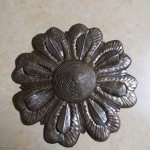 Whenever I sell a Haitian metal sculpture, whether at a show or a street fair or holiday bazaar, I am always pleased when our customers walk away happy and confident with their purchase. But sometimes I have to chuckle at the process. When something is brand new and shiny and wonderful, the ready instinct is to be careful with it. And it’s a good instinct to follow, usually. On the continuum of action between cautious and bold there are times when one should be exercised over the other. Sometimes being cautious is the right choice. And sometimes you have to be bold and bend your sculpture.
Whenever I sell a Haitian metal sculpture, whether at a show or a street fair or holiday bazaar, I am always pleased when our customers walk away happy and confident with their purchase. But sometimes I have to chuckle at the process. When something is brand new and shiny and wonderful, the ready instinct is to be careful with it. And it’s a good instinct to follow, usually. On the continuum of action between cautious and bold there are times when one should be exercised over the other. Sometimes being cautious is the right choice. And sometimes you have to be bold and bend your sculpture.
“Bend it?” you say. Yes, bend it. Many of our sculptures have a three dimensional element and sometimes you have to bend that element out to make it “pop” to give it the depth that it deserves. For instance, in the photos at the left, you will see a great little daisy sculpture by Caleb Belony. In the first photo, the petals are all flush with each other. Completely flat. That’s how we pack them to be shipped, whether to The Flower Show in Philadelphia or to your Great Aunt Tilly in Tuscaloosa. It’s more 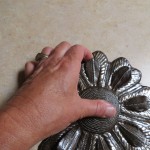 compact, takes up less bulk and all of that good stuff.
compact, takes up less bulk and all of that good stuff.
However, when you go to hang that sculpture, you need to bend those petals out a little bit. Go ahead. Do it boldly, with grit and determination. You’ll see the difference immediately. It’s got more pizzazz, more life. It looks more like a daisy. The same is true of most of our winged sculptures, such as our birds, dragonflies, butterflies, and angels. A big clue on wings is if they are attached with a rivet. If so, go ahead and bend it out.
Of course I will tell you that bending is not limited to elements that are riveted. Case in point, the flower at the left. Some dragonflies don’t have rivets, but the wings look better bent out a little bit anyway. Same with some of our curly haired girls and masks. If you think your sculpture might look more lively that way, give it a try. (You can always bend it boldly back!)

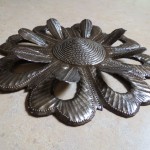


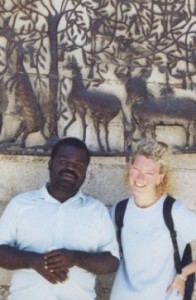
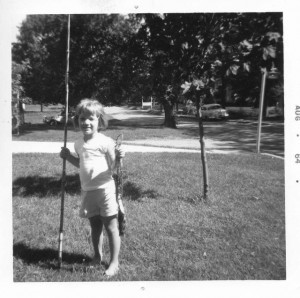
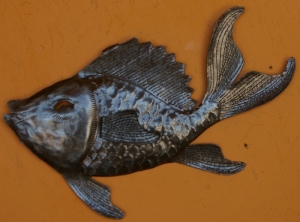
![Chihuly_at_Kew_Gardens_043[1] (640x480)](https://blog.itscactus.com/wp-content/uploads/2012/09/Chihuly_at_Kew_Gardens_0431-640x480-150x150.jpg)
![the-girl-with-a-pearl-earring-johannes-vermeer-t14769[1] (354x500)](https://blog.itscactus.com/wp-content/uploads/2012/09/the-girl-with-a-pearl-earring-johannes-vermeer-t147691-354x500-150x150.jpg) color or pattern? All of those elements play their part, to be sure. Still, my guess is that when you look at a piece of art, whether it’s a 17th century painting by Jan Vermeer, or a contemporary piece of glasswork by Dale Chihuly, or a piece of Haitian folk art by Jean Eugene Remy, it is the details that draw you in.
color or pattern? All of those elements play their part, to be sure. Still, my guess is that when you look at a piece of art, whether it’s a 17th century painting by Jan Vermeer, or a contemporary piece of glasswork by Dale Chihuly, or a piece of Haitian folk art by Jean Eugene Remy, it is the details that draw you in.![ht01387[1]](https://blog.itscactus.com/wp-content/uploads/2012/09/ht0138711.jpg) effect of the basket is achieved by cutting the contents backwards as a side piece and then bending the metal tightly behind the slitted, concave basket. A little bit more time spent in execution, but the result is good visual impact. A fine detail
effect of the basket is achieved by cutting the contents backwards as a side piece and then bending the metal tightly behind the slitted, concave basket. A little bit more time spent in execution, but the result is good visual impact. A fine detail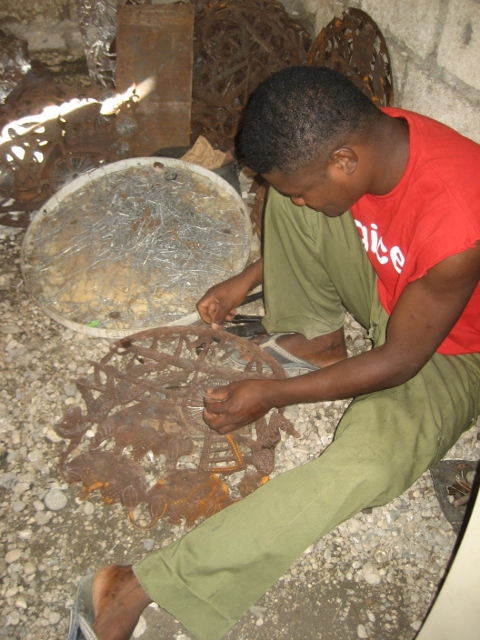 And the bus itself. Notice how small caps have been hand-riveted on the front end as headlights. Clever. The wheels, however, are the coup d’grace. They revisit vintage wire wheel hubcaps on Corvettes and Cadillacs, 1968-1982. (Yes, I looked it up, and by-the-way, you can find them on ebay for about $1250, if you’re in the market.) Jean Eugene innovatively uses spout caps and rivets and wire hooks, which are bent one at a time to create each spoke. Fifty-seven in the back and sixty-three in the front. Talk about detail!
And the bus itself. Notice how small caps have been hand-riveted on the front end as headlights. Clever. The wheels, however, are the coup d’grace. They revisit vintage wire wheel hubcaps on Corvettes and Cadillacs, 1968-1982. (Yes, I looked it up, and by-the-way, you can find them on ebay for about $1250, if you’re in the market.) Jean Eugene innovatively uses spout caps and rivets and wire hooks, which are bent one at a time to create each spoke. Fifty-seven in the back and sixty-three in the front. Talk about detail!